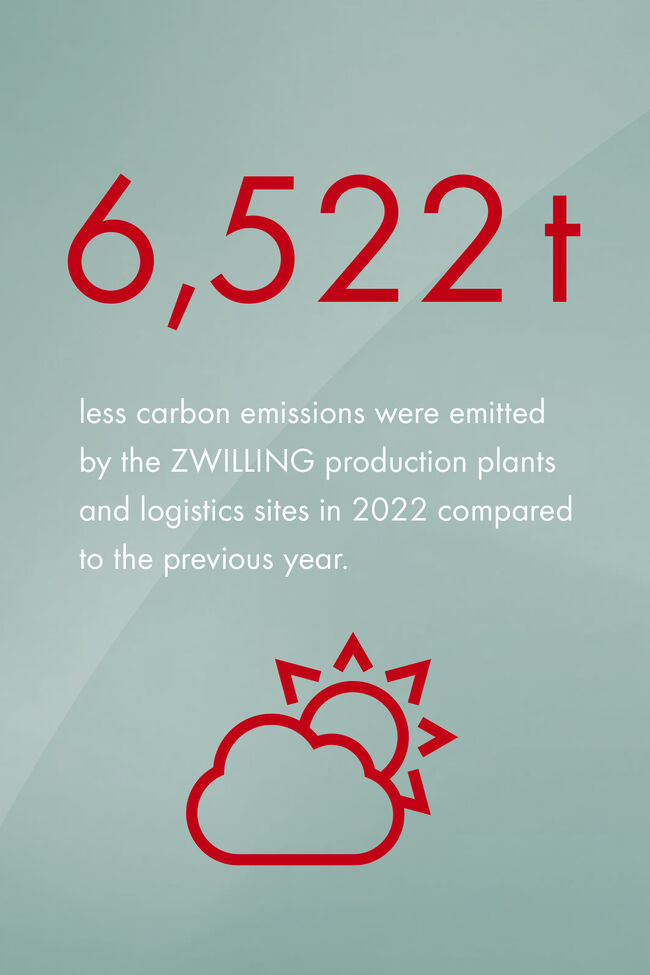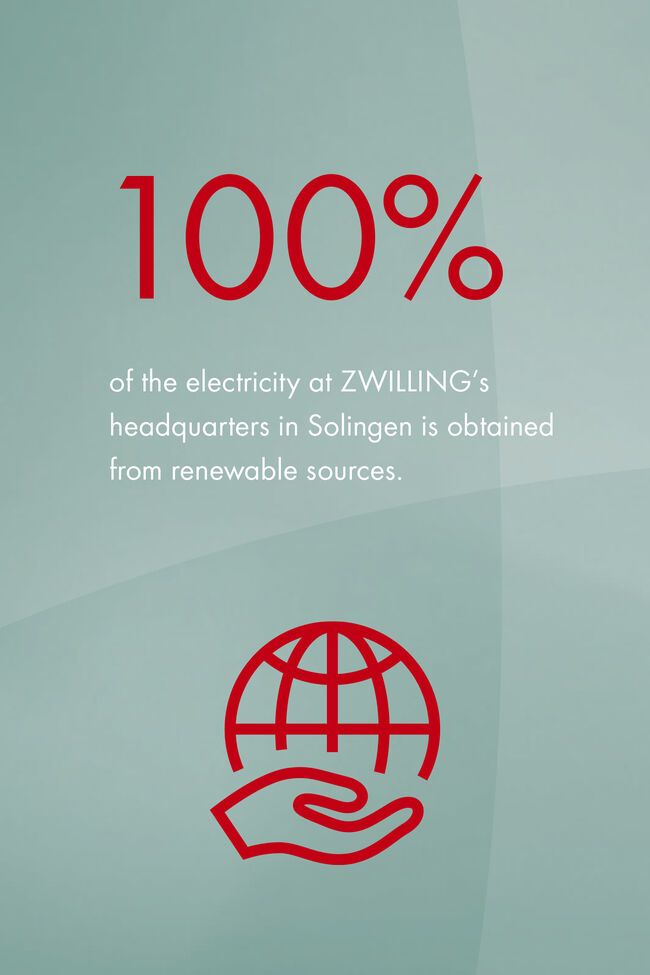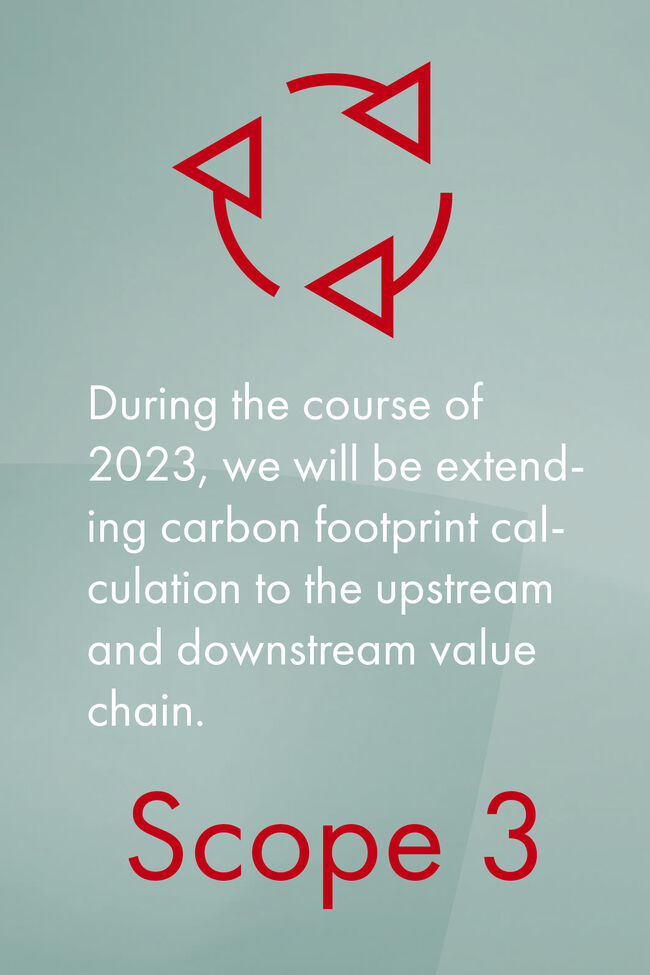- Home
- Magazine
- Culinary World
- Sustainability
- Energy efficiency & environment

Energy efficiency & environment
As a manufacturing company, we recognize our responsibility. Fortunately, there is a high potential for energy savings in areas with significant energy consumption. Our focus is on reducing our CO2 emissions by switching to renewable electricity sources and saving energy at production sites. Additionally, we are launching innovative products that enable everyone to use less energy when cooking at home.
Our commitment in figures





Focus on climate protection
Climate researchers agree that to stop global warming, we must curb CO2 emissions and reduce them to zero by 2050. At ZWILLING, we want to contribute to maintaining the 1.5°C target from the Paris Agreement.
In 2022, we transformed our sustainability program into an ambitious climate strategy. Based on the Net-Zero Standard of the Science Based Targets initiative (SBTi), we focus on cutting greenhouse gas emissions. To achieve these goals, we have set the following targets:
- By 2030, we are committed to reducing the absolute carbon emissions from production and logistics sites (Greenhouse Gas Protocol Scope 1 and 2) by 42 percent compared to 2021.
- In 2023, we will be extending climate reporting to include the upstream and downstream value chain (Scope 3)
- As a next step, we will define our long-term reduction targets for 2050 and have them evaluated by the SBTi.

Reducing emissions: how we will do it
To implement our reduction target at each individual ZWILLING site, we analyzed the most efficient ways to reduce our CO2 emissions. We can achieve the greatest savings by switching our ZWILLING production facilities, warehouses, and shops to renewable electricity. We accomplish this by investing in climate-friendly technologies and further improving the energy efficiency of our processes.

We have already launched many initiatives to reduce greenhouse gas emissions at our sites:
- The ZWILLING headquarters in Solingen uses 100% green electricity.
- The ZWILLING site in Pleasantville (USA) covers part of its electricity requirements with self-generated solar energy.
- BALLARINI generates its own electricity in Rivarolo, Italy, using solar energy.
- In the new enameling line at STAUB, the waste heat generated is fed back into the furnaces, reducing energy requirements.
- The production and logistics sites are gradually converting their lighting to low-emission LED technology.

We aim to continuously improve the figures reported for Scope 1 and Scope 2 emissions (see section Focus on climate protection). To achieve this, we are harmonizing data collection and KPI reporting throughout the ZWILLING Group. We’ve already taken the first step: in 2022, we equipped all European locations with a measurement infrastructure.
The advantages: We can record the underlying consumption data automatically. In addition, all production sites report their monthly energy consumption. This means we now have a standardized database for our carbon factors.

In 2023, we extended our carbon accounting to our shops and offices, as well as the upstream and downstream value chain (Scope 3, see section Focus on climate protection). We hope this will motivate our suppliers to measure and reduce their emissions. We are also setting our long-term net zero target for 2050. By the end of 2024, we aim to have fulfilled the requirements for validation by the Science Based Targets Initiative.
Efficient use of energy and resources

Using finite resources carefully is a top priority for us. To reduce the consumption of resources, we focus on waste separation and recycling. Waste produced at all our production sites is separated in accordance with the applicable legislation. Additionally, we will continue to optimize the recycling of materials. What we are already doing:
- We recycle the metal shavings and offcuts from our die-cutting processes.
- Our integrated water and wastewater management system allows us to recycle the process water at our production sites as efficiently as possible.
- We treat our industrial process water to prevent water quality from being impaired by the accidental introduction of contaminants.

Pans with the THERMOTION heat indicator can now easily reach the ideal cooking temperature. When the indicator in the pan handle pops up, it’s reached the ideal frying temperature. You can now adjust the intensity of the heat and avoid wasting energy. Once the pan has cooled down again, the indicator retracts, and the cookware can be safely handled and washed.

Energy is consumed not only during the ongoing production process but also after the end of the shift. We analyzed power consumption outside of production hours at our energy-intensive upset forging plant in Solingen and used the results to optimize system shutdown processes. Initial projections showed that by utilizing this strategy, we can cut consumption by around 100,000 kWh per year, depending on capacity utilization at the plant. In the future, we will implement this strategy in other parts of production in Solingen.
Your account will be deleted!
Notify me when available
Error: This field is required









